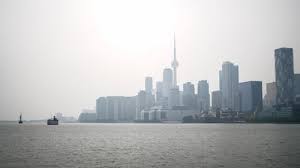Environment Canada is warning of poor air quality and extreme heat in Toronto on Monday as southern Ontario braces for a week filled with hot and humid weather.
An air quality warning was issued for the city late Sunday night as smoke from forest fires over northern Ontario move into the area and cause air quality to “deteriorate significantly,” the national weather agency said.
Toronto will see a daytime high of 31 C today, feeling closer to 40 with the humidity. A heat warning remains in effect for the city and sweltering conditions are expected to persist for much of the week.
Environment Canada said the poor air quality may continue through the day and potentially into Tuesday for some areas.
Toronto’s air quality is currently ranked second worst in the world, according to data from Swiss air quality tracker IQAir.
“People more likely to be impacted by wildfire smoke, including people aged 65 and older, pregnant people, infants and young children, people with an existing illness or chronic health condition, and people who work outdoors, should avoid strenuous activities outdoors and seek medical attention if experiencing symptoms,” the advisory read.
“During heavy smoke conditions, everyone’s health is at risk regardless of their age or health status. Limit time outdoors. Reschedule or cancel outdoor sports, activities and events.”
A high of 32 C is expected on Tuesday, feeling like 37 when factoring in the humidity.
“Southern Ontario will experience hot and humid conditions now through much of this week,” Environment Canada’s advisory read.
“A shift in the weather pattern late this week will likely end this multi-day period of heat and humidity Thursday night.”
Humidex values of between 35 and 40 are expected throughout the week and overnight lows of between 19 and 23 C will provide “little relief from the heat,” the advisory continued.
“Take action to protect yourself and others – extreme heat can affect everyone’s health,” the national weather agency said.
“Determine if you or others around you are at greater risk of heat illness. Check on older adults, those living alone and other at-risk people in-person or on the phone multiple times a day. Watch for the early signs of heat exhaustion in yourself and others.”


